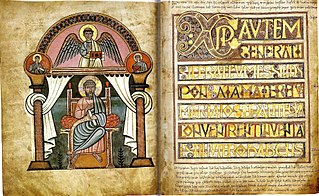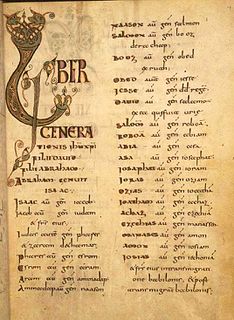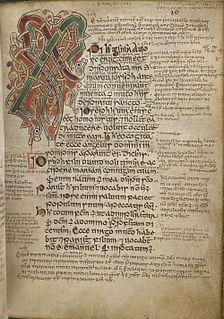
The Book of Kells is an illuminated manuscript Gospel book in Latin, containing the four Gospels of the New Testament together with various prefatory texts and tables. It was created in a Columban monastery in either Scotland, England or Ireland and may have had contributions from various Columban institutions from each of these areas. It is believed to have been created c. 800 AD. The text of the Gospels is largely drawn from the Vulgate, although it also includes several passages drawn from the earlier versions of the Bible known as the Vetus Latina. It is a masterwork of Western calligraphy and represents the pinnacle of Insular illumination. It is also widely regarded as one of Ireland's finest national treasures. The manuscript takes its name from the Abbey of Kells, which was its home for centuries.

The Codex Alexandrinus is a fifth-century Christian manuscript of a Greek Bible, containing the majority of the Greek Old Testament and the Greek New Testament. It is one of the four Great uncial codices. Along with the Codex Sinaiticus and the Vaticanus, it is one of the earliest and most complete manuscripts of the Bible. Brian Walton assigned Alexandrinus the capital Latin letter A in the Polyglot Bible of 1657. This designation was maintained when the system was standardized by Wettstein in 1751. Thus, Alexandrinus held the first position in the manuscript list.

British Library, Add MS 40618 is a late 8th century illuminated Irish Gospel Book with 10th century Anglo-Saxon additions. The manuscript contains a portion of the Gospel of Matthew, the majority of the Gospel of Mark and the entirety of the Gospels of Luke and John. There are three surviving Evangelist portraits, one original and two 10th century replacements, along with 10th century decorated initials. It is catalogued as number 40618 in the Additional manuscripts collection at the British Library.

British Library, Add MS 11848 is an illuminated Carolingian Latin Gospel Book produced at Tours. It contains the Vulgate translation of the four Gospels written on vellum in Carolingian minuscule with Square and Rustic Capitals and Uncials as display scripts. The manuscript has 219 extant folios which measure approximately 330 by 230 mm. The text is written in area of about 205 by 127 mm. In addition to the text of the Gospels, the manuscript contains the letter of St. Jerome to Pope Damasus and of Eusebius of Caesarea to Carpian, along with the Eusebian canon tables. There are prologues and capitula lists before each Gospel. A table of readings for the year was added, probably between 1675 and 1749, to the end of the volume. This is followed by a list of capitula incipits and a word grid which were added in the Carolingian period.

The Codex Beneventanus is an 8th-century illuminated codex containing a Gospel Book. According to a subscription on folio 239 verso, the manuscript was written by a monk named Lupus for one Ato, who was probably Ato, abbot (736–760) of the monastery of San Vincenzo al Volturno, near Benevento. The unusual odd number of Canon Tables suggests these seven folios were prepared as much as two centuries earlier than the rest of the codex.

The Stockholm Codex Aureus is a Gospel book written in the mid-eighth century in Southumbria, probably in Canterbury, whose decoration combines Insular and Italian elements. Southumbria produced a number of important illuminated manuscripts during the eighth and early ninth centuries, including the Vespasian Psalter, the Stockholm Codex Aureus, three Mercian prayer books, the Tiberius Bede and the British Library's Royal Bible.
British Library, Royal MS 1. B. VII is an 8th-century Anglo-Saxon illuminated Gospel Book. It is closely related to the Lindisfarne Gospels, being either copied from it or from a common model. It is not as lavishly illuminated, and the decoration shows Merovingian influence. The manuscript contains the four Gospels in the Latin Vulgate translation, along with prefatory and explanatory matter. It was presented to Christ Church, Canterbury in the 920s by King Athelstan, who had recorded in a note in Old English (f.15v) that upon his accession to the throne in 925 he had freed one Eadelm and his family from slavery, the earliest recorded manumission in (post-Roman) England.

The Schuttern Gospels is an early 9th century illuminated Gospel Book that was produced at Schuttern Abbey in Baden. According to a colophon on folio 206v, the manuscript was written by the deacon Liutharius, at the order of his abbot, Bertricus.

British Library, Egerton MS 609 is a Breton Gospel Book from the late or third quarter of the ninth century. It was created in France, though the exact location is unknown. The large decorative letters which form the beginning of each Gospel are similar to the letters found in Carolingian manuscripts, but the decoration of these letters is closer to that found in insular manuscripts, such as the Book of Kells and the Lindisfarne Gospels. However, the decoration in the Breton Gospel Book is simpler and more geometric in form than that found in the Insular manuscripts. The manuscript contains the Latin text of St Jerome's letter to Pope Damasus, St. Jerome's commentary on Matthew, and the four Gospels, along with prefatory material and canon tables. This manuscript is part of the Egerton Collection in the British Library.

The Fécamp Bible is an illuminated Latin Bible. It was produced in Paris during the third quarter of the 13th century, and had previously belonged in the collection of Henry Yates Thompson.

The Utrecht Psalter is a ninth-century illuminated psalter which is a key masterpiece of Carolingian art; it is probably the most valuable manuscript in the Netherlands. It is famous for its 166 lively pen illustrations, with one accompanying each psalm and the other texts in the manuscript. The precise purpose of these illustrations, and the extent of their dependence on earlier models, have been matters of art-historical controversy. The psalter spent the period between about 1000 to 1640 in England, where it had a profound influence on Anglo-Saxon art, giving rise to what is known as the "Utrecht style". It was copied at least three times in the Middle Ages. A complete facsimile edition of the psalter was made in 1875, and another in 1984 (Graz).

The Stowe Psalter is a psalter from the "2nd or 3rd quarter of the 11th century", at the end of Anglo-Saxon art. The text includes the Gallican version of the Psalms, followed by the Canticles with an interlinear Old English gloss.

The Gospels of Máel Brigte is an illuminated Gospel Book, with glosses.

A biblical manuscript is any handwritten copy of a portion of the text of the Bible. Biblical manuscripts vary in size from tiny scrolls containing individual verses of the Jewish scriptures to huge polyglot codices containing both the Hebrew Bible (Tanakh) and the New Testament, as well as extracanonical works.

Minuscule 113, ε 134 (Soden), is a Greek minuscule manuscript of the New Testament, on parchment leaves. Paleographically it has been assigned to the 11th-century.

Minuscule 116, ε 249 (Soden), is a Greek minuscule manuscript of the New Testament, on parchment leaves. Palaeographically it has been assigned to the 12th century. It has complex contents with some marginalia.

Lectionary 183, designated by siglum ℓ183 is a Greek manuscript of the New Testament, on parchment, written in uncial letters. Westcott and Hort labelled it by 38e, Scrivener by 257e. Paleographically usually it has been assigned to the 10th century. The manuscript has some lacunae at the end and inside, but they were supplied by a later hand. It is faded in parts.

Minuscule 505, ε 248, is a Greek minuscule manuscript of the New Testament, on parchment. Palaeographically it has been assigned to the 12th-century. Scrivener labelled it by number 567. The manuscript has complex contents. It was adapted for liturgical use.
Minuscule 994 (in the Gregory-Aland numbering), A227 Cι33 (von Soden), is a 10th or 11th-century Greek minuscule manuscript of the New Testament on parchment. The manuscript has not survived in complete condition. It has some marginalia.

















